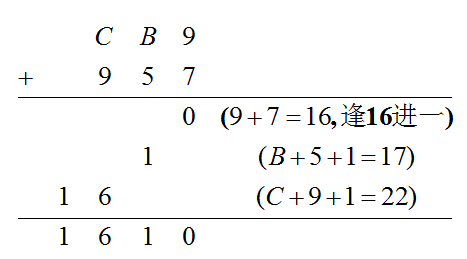EOJ 3037 十六进制加法
请编写程序实现两个十六进制整数的加法。
例如:十六进制整数 3762 和 05C3,3762+05C3 =3D25
十六进制整数 CB9 和 957,CB9+957=1610

Input
第 1 行:一个整数 T (1≤T≤10) 为问题数。
接下来 T 行,每行输入两个十六进制整数 n 和 m (n,m 为不超过 200 位的十六进制整数),A~F 全部为大写字母。 两个整数之间用一个空格分隔。
Output
对于每个问题,输出一行问题的编号(0 开始编号,格式:case #0: 等)。然后对应每个问题在一行中输出两个十六进制整数相加的结果,字母全部用大写字母。
1 #include <stdio.h> 2 #include <stdlib.h> 3 int init(char *a) 4 { 5 char c; 6 int pos=1; 7 while((c=getchar())!=' '&&c!='\n') 8 a[pos++]=c; 9 a[pos]=0; 10 return pos-1; 11 }//返回值是为了确定两个数组的长度 12 int ctoi(char c) {return (c>='0'&&c<='9')?c-'0':c-'A'+10;} 13 char itoc(int i) {return i<=9?i+'0':i-10+'A';} 14 void add(char* to,char* from,int t,int f) 15 { 16 int carry;char plus='0'; 17 for(;from[f]!=0;f--,t--) 18 { 19 carry=ctoi(to[t])+ctoi(from[f])+ctoi(plus); 将两位转化成整数后相加 20 to[t]=itoc(carry%16); 21 plus=itoc(carry/16);//进位 22 } 23 while(t>=0&&(carry=ctoi(to[t])+ctoi(plus))>0)//不停进位的情况 24 { 25 to[t]=itoc(carry%16); 26 plus=itoc(carry/16); 27 t--; 28 } 29 if(plus>'0') 30 to[0]=plus;//留下一位空格以放置最后的进位 31 } 32 void print(char *s) 33 { 34 char *p=s; 35 if(p[0]==0) p++;//遗留的空位可能没有被使用 36 printf("%s\n",p); 37 } 38 int main() 39 { 40 int cas;scanf("%d",&cas);getchar(); 41 for(int m=0;m<cas;m++) 42 { 43 char a[202],b[202]; 44 int pa,pb; 45 a[0]=b[0]=0;//留下一位空格以放置最后的进位 46 pa=init(a); 47 pb=init(b); 48 printf("case #%d:\n",m); 49 if(pa>=pb)//哪个长就把结果放置在哪个里 50 { 51 add(a,b,pa,pb); 52 print(a); 53 } 54 else 55 { 56 add(b,a,pb,pa); 57 print(b); 58 } 59 } 60 return 0; 61 }
类似于大整数,还是有固定的模板的。



